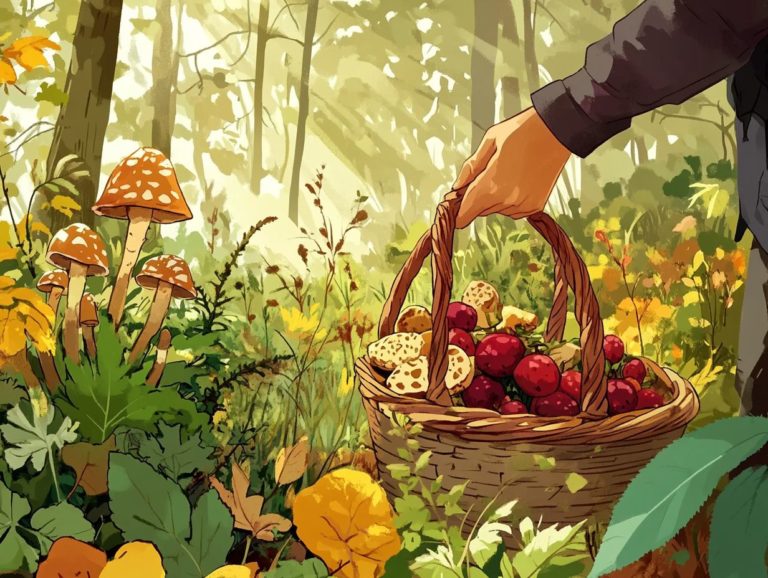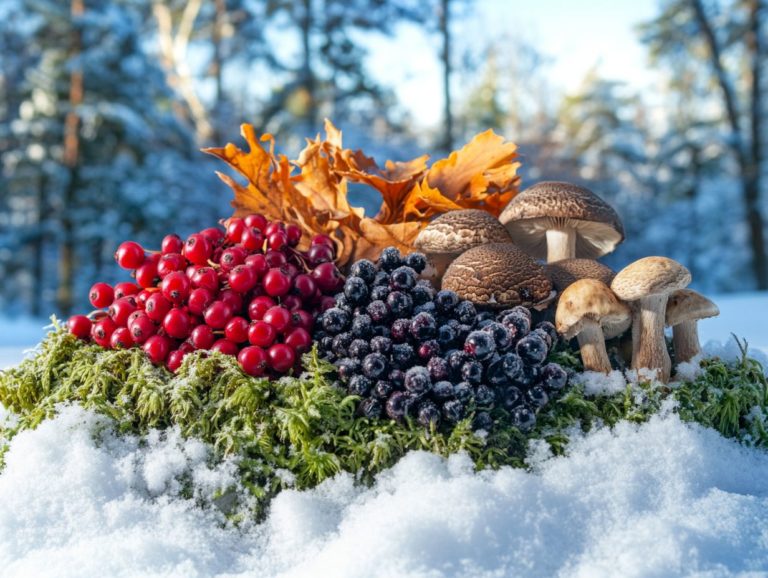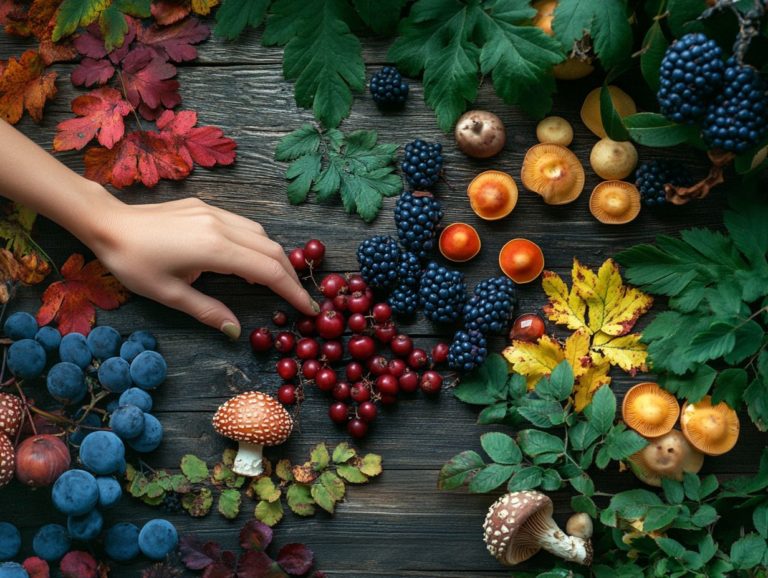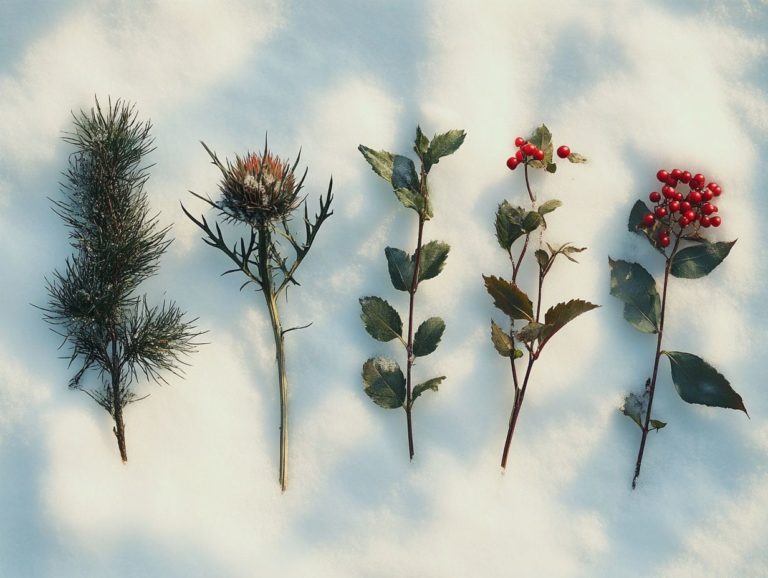Wild Edibles: What to Forage in Winter
Winter might appear to be a desolate season to forage, yet it is a hidden treasure trove of wild edibles just waiting for you to uncover.
This exploration delves into the many benefits of foraging during the colder months, emphasizing the remarkable nutritional value and accessibility of winter’s wild offerings. You ll gain insights on how to identify and harvest common edible plants, along with crucial safety precautions to ensure you avoid any missteps.
You ll discover inventive wild recipes that will elevate your foraged finds into exquisite meals. Join us on this exciting adventure of winter foraging!
Contents
- Key Takeaways:
- The Basics of Winter Forage
- Benefits of Foraging for Wild Edibles in Winter
- Common Wild Edibles to Forage in Winter
- Safety Precautions for Winter Foraging
- Preparing and Cooking Winter Foraged Foods
- Frequently Asked Questions
- What are some wild edibles that can be foraged, including foraging skills in winter?
- Are there any poisonous wild edibles that look similar to safe ones?
- Can wild edibles still be foraged in the winter when there is snow on the ground?
- What are some safety precautions to keep in mind when foraging for wildcrafting plants for wild edibles in winter, such as conifer trees, and exploring seaweed foraging?
- Are there any tools or equipment that are necessary for foraging wild edibles in winter?
- Can wild edibles be frozen or preserved for later use?
Key Takeaways:
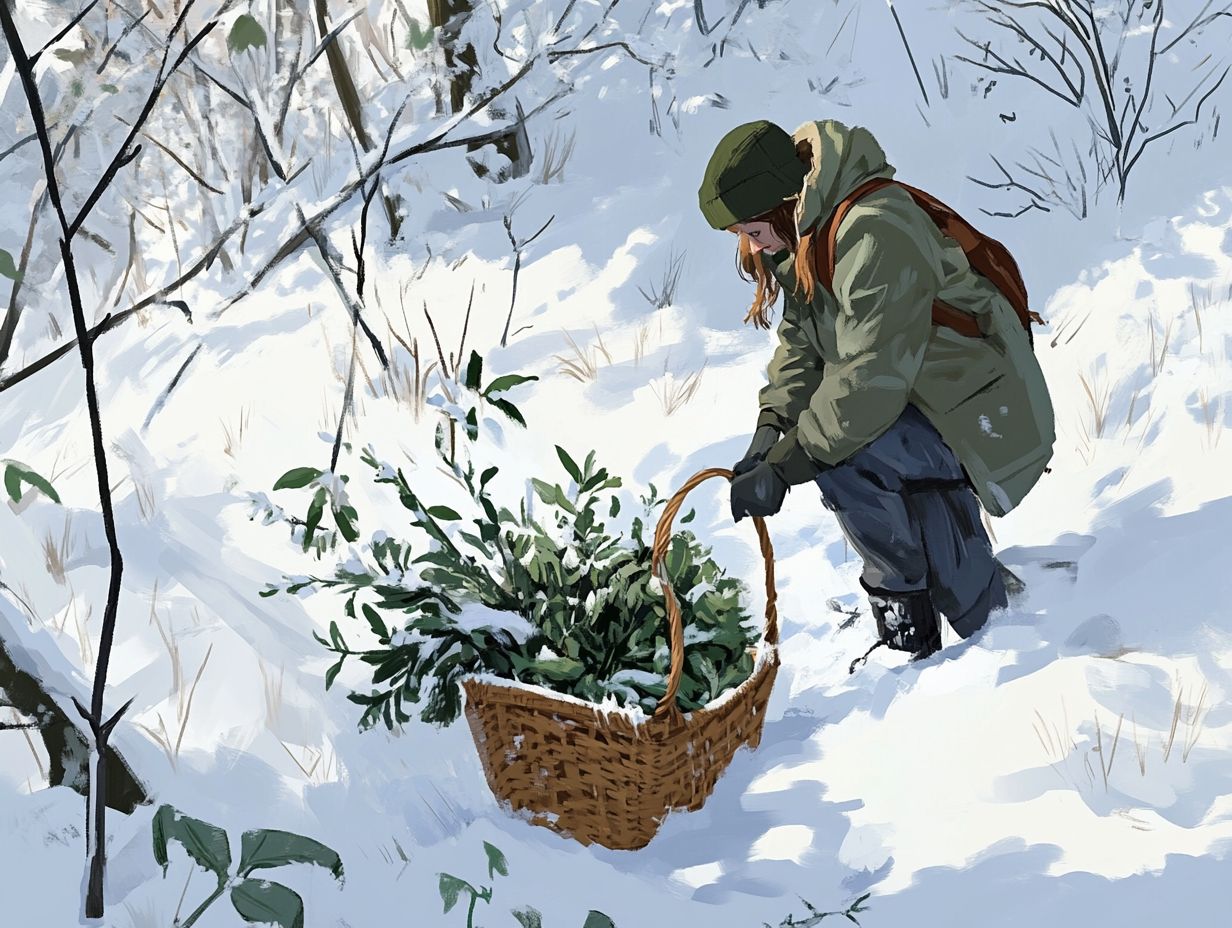
- Winter foraging can provide a wide variety of nutritious wild edibles, despite the colder weather.
- It is important to properly identify and harvest wild edibles, as well as take precautions to avoid poisonous plants and contaminants.
- With creativity and knowledge of preparation techniques, foraged winter foods can be turned into delicious and unique dishes.
The Basics of Winter Forage
Winter foraging is a vital skill that enables you to source nutrient-rich foods from nature during the colder months. Many conventional food options dwindle during this time.
By honing your ability to identify edible plants, medicinal plants, mushrooms, nuts, and other wild foods, you can sustain yourself while unearthing the medicinal properties of various plants and fungi that your local environment offers.
Grasping the fundamentals of winter foraging means recognizing the unique traits of wintergreen plants, conifer trees, and other resilient winter foods that thrive despite the chill. This knowledge enables you to practice wildcrafting and forage sustainably, making the most of the winter landscape.
Benefits of Foraging for Wild Edibles in Winter
Foraging in winter discovers amazing benefits, granting you access to nutrient-rich foods that are not only delectable but also packed with the essential vitamins and minerals your body craves during the colder months.
Foraging in winter allows you to forge a deeper connection with nature, hone your practical foraging skills, and discover the diverse array of edible plants and mushrooms think hawthorn berries and wintergreen while also uncovering herbal remedies that may enhance your well-being.
The insights you gain from a foraging course equip you to safely and sustainably harvest these wild foods, ultimately enriching your holistic lifestyle.
Nutritional Value and Availability
The nutritional value of wild edible plants available in winter may surprise you; many of these foods are brimming with vitamins, minerals, and antioxidants that can significantly enhance your health during the frigid months.
During this time, you might stumble upon hidden treasures like chickweed, which is rich in vitamins A and C, or the often-overlooked burdock root, celebrated for its impressive levels of dietary fiber and antioxidants, and wild garlic.
Winter foraging not only introduces you to these nutrient-dense options but also invites you to reconnect with nature s bountiful offerings. Incorporating these ingredients into your meals, including chaga fungus and medicinal mushrooms, can combat the seasonal blues and strengthen your immune system, making the pursuit of wild edibles a rewarding journey for both culinary enthusiasts and health-conscious individuals.
Common Wild Edibles to Forage in Winter
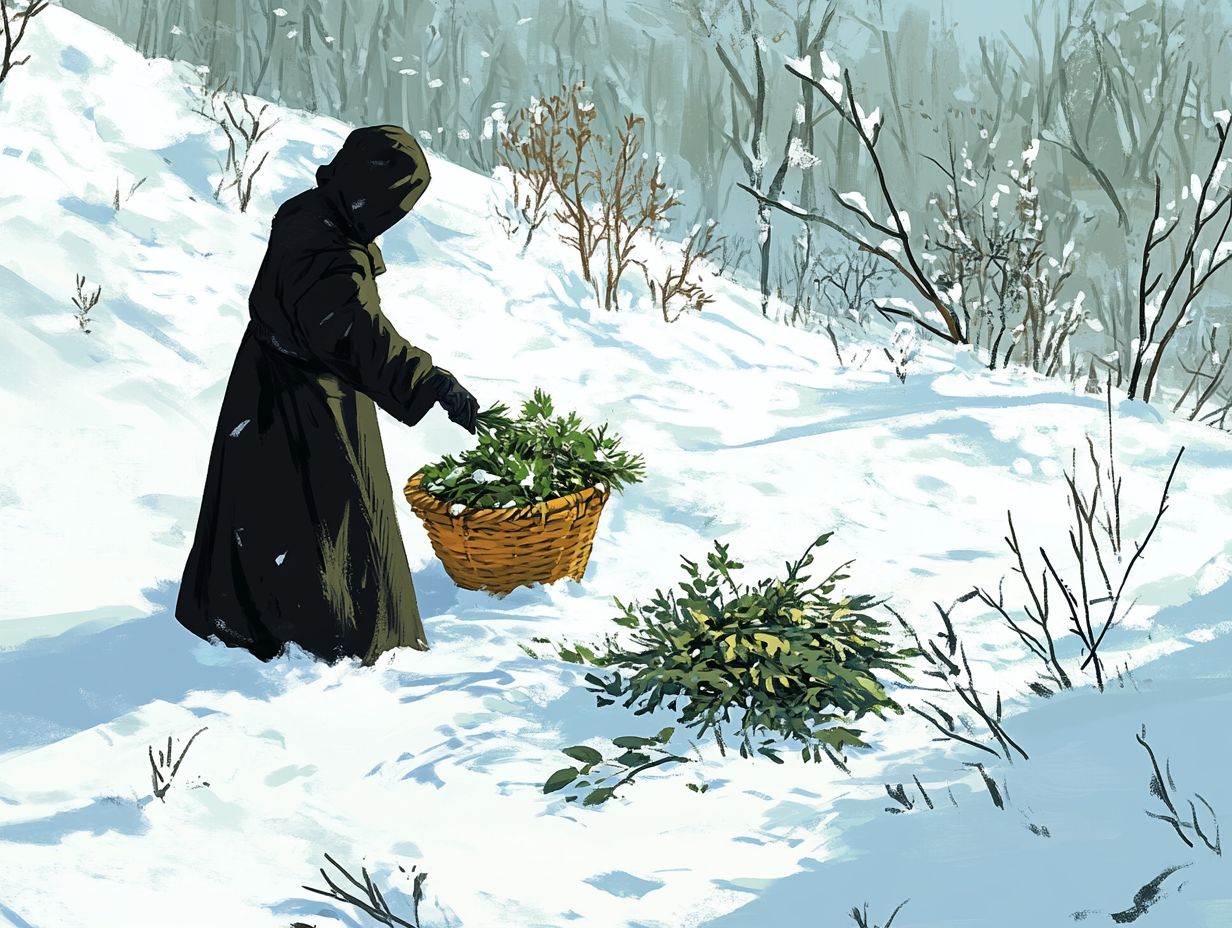
In winter, you have the opportunity to forage a variety of wild edibles that can enhance your diet with exceptional flavors and notable nutritional benefits.
Consider hawthorn berries, which make for delightful rose hips tea, or juniper berries, celebrated for their culinary and medicinal virtues. You might also explore the maple sap, known for its sweet essence and potential health advantages.
Additionally, medicinal mushrooms such as turkey tail mushrooms and chaga fungus provide abundant antioxidants, transforming your winter foraging adventure into a treasure trove of beneficial additions.
Identifying and Harvesting Tips
Identifying and harvesting wild edible plants during winter requires a keen eye and the right skills to distinguish between safe and potentially harmful species. It’s crucial for you to understand the characteristics of edible wild plants, such as chickweed, which can often be found even beneath a blanket of snow.
Recognizing the signs of safe-to-consume plants, like the distinctive shapes of hickory nuts and acorns, is equally important.
Practice and study will develop your foraging skills, greatly enhancing both the experience and safety of your winter foraging adventures.
Winter doesn t signal the end of foraging; rather, it offers a unique chance to deepen your knowledge of edible species that thrive in colder conditions. If you re eager to explore the world of wildcrafting the practice of gathering wild plants for food or medicinal purposes knowing the habitats where these plants grow is just as vital as recognizing their identifying features, including cattail roots and lichen harvesting.
Gaining insights from seasoned foragers and utilizing field guides will significantly boost your confidence when selecting plants.
Techniques such as observing soil quality and understanding seasonal changes play an essential role in successful foraging. A blend of thorough research, local knowledge, and hands-on experience will form the backbone of your safe winter foraging expeditions.
Safety Precautions for Winter Foraging
When you embark on winter foraging, prioritizing safety precautions is essential to guarantee that the wild edibles you gather are not only safe for consumption but also free from contaminants.
It s crucial to familiarize yourself with the poisonous plants that could easily be mistaken for their edible counterparts take, for instance, the deadly nightshade, which bears a striking resemblance to some safe wild varieties.
Arming yourself with knowledge about poisonous plants, along with proper harvesting techniques and a keen awareness of your surroundings, including plant identification skills, can significantly diminish the risk of accidental poisoning and cultivate a safe and rewarding foraging experience.
Avoiding Poisonous Plants and Contaminants
Avoiding poisonous plants and contaminants is absolutely essential for ensuring a safe and enjoyable winter foraging experience. Many wild edibles have look-alikes that can pose serious health risks.
Developing diligent plant identification skills and gaining knowledge of local flora will enable you to distinguish between safe options like rose hips and those potentially harmful varieties.
Be aware of environmental contaminants to ensure that the plants you harvest remain safe for consumption. Understanding local soil conditions and potential pollutants is equally vital, as these contaminants can accumulate in plants, rendering them hazardous.
Always consult local guidelines and databases that specifically list toxic species prevalent in your area. Joining foraging groups or workshops can significantly enhance your learning experience.
Utilizing reliable field guides will also help you differentiate between safe and unsafe plants, especially for wild planting and food foraging. Steering clear of areas near roadsides or industrial zones minimizes your exposure to harmful substances, ensuring that what you gather during these winter months positively contributes to your health and well-being.
Preparing and Cooking Winter Foraged Foods
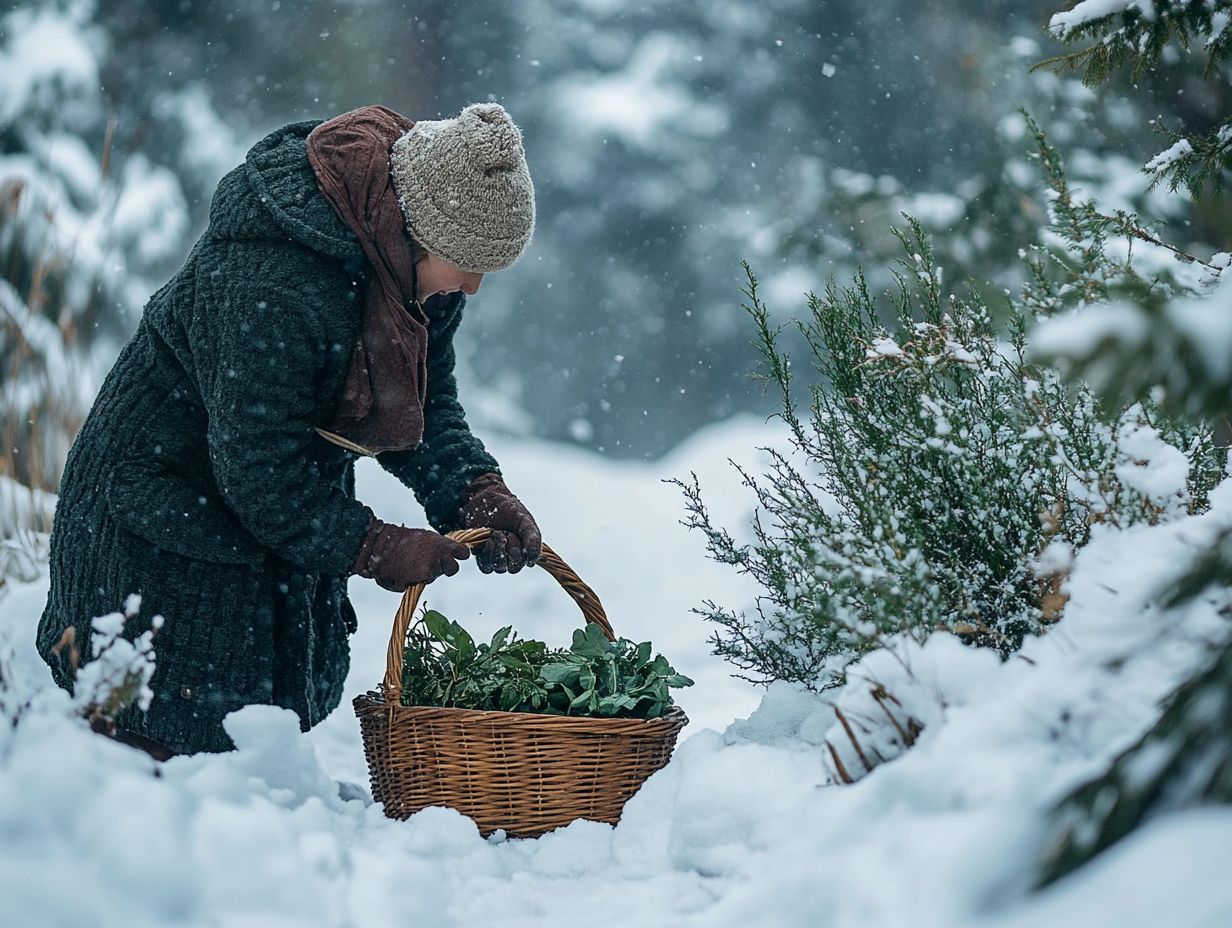
Transform winter foraged foods into delightful meals and herbal remedies that nourish and invigorate your body. Imagine crafting a warming pine needle tea, infusing flavors with birch bark tea, or elevating hearty winter dishes with wild garlic and chickweed.
You will enjoy mastering the intricacies of processing these foraged treasures. This not only enhances their culinary appeal but also maximizes their nutritional benefits, ensuring you enjoy satisfying meals throughout the winter season.
Creative Recipes and Techniques
Creative recipes and techniques can truly elevate your experience with winter foraged foods. They showcase the unique flavors and health benefits of wild edibles.
By incorporating ingredients like medicinal mushrooms and seaweed from your foraging adventures, you can experiment with hearty soups or innovative teas like rose hips tea that provide nourishment and comfort during the colder months.
Exploring the versatility of these ingredients, including seaweed foraging, allows you to savor your harvest while deepening your appreciation for the art of wildcrafting and seasonal cooking.
Utilizing foraged greens like nettle or dandelion, you can whip up nutrient-rich salads or pesto that are bursting with vitamins and minerals. Experimenting with infused oils oils mixed with herbs to enhance flavor from wild herbs can introduce a delightful burst of flavor to roasted vegetables or winter stews. Adding black walnuts can provide an extra crunch.
Each dish you create tells a story of the environment and season, inviting you to dive into nature with every bite.
This culinary exploration fosters a sense of adventure in the kitchen, inspiring even the most novice cooks to embrace the bounty of winter s natural pantry.
Frequently Asked Questions
What are some wild edibles that can be foraged, including foraging skills in winter?
Some common wild edibles that can be foraged in winter include edible wild plants such as Oregon grape, cattail roots, wintergreen, wild berries, nuts, and greens like rose hips, hawthorn berries, acorns, and chickweed.
Are there any poisonous wild edibles that look similar to safe ones?
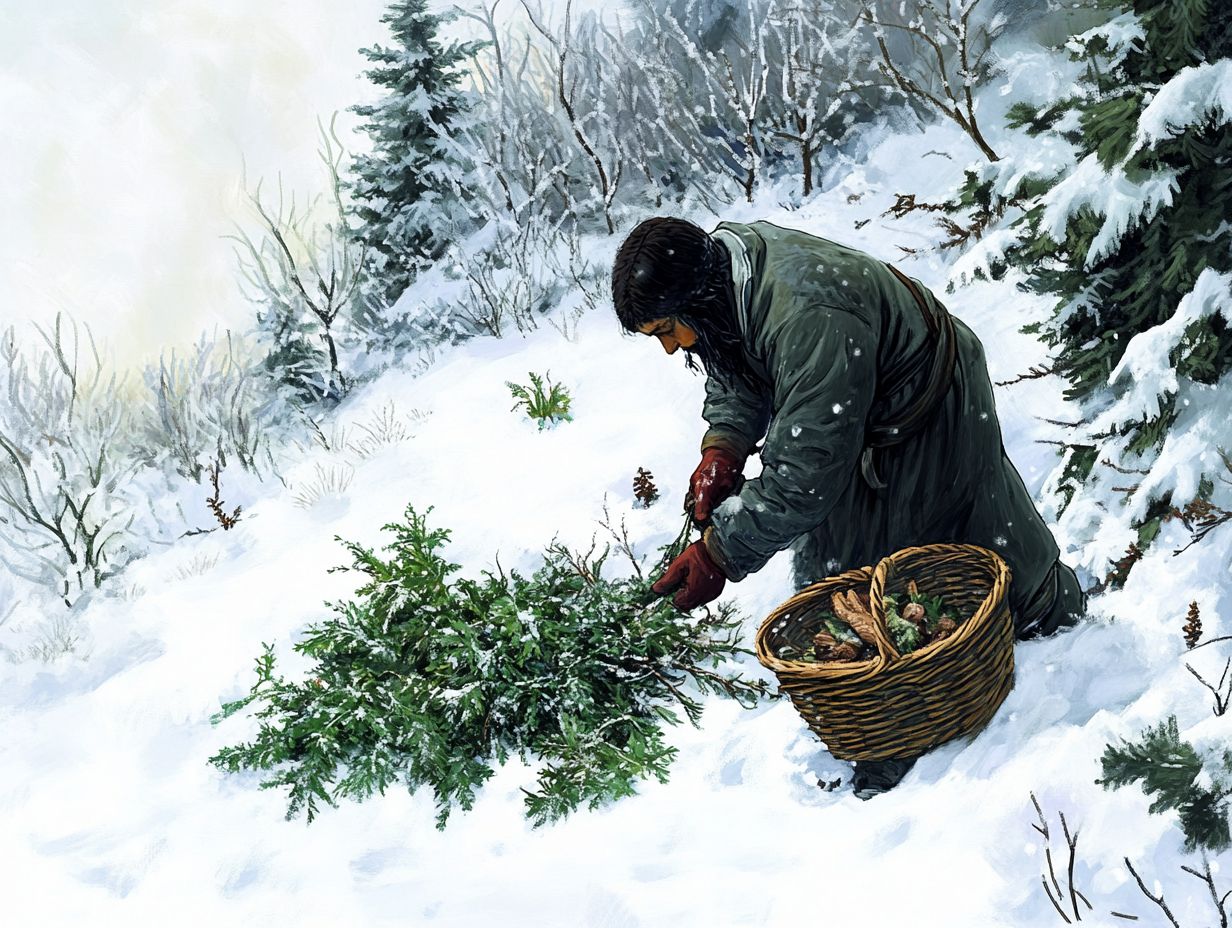
Yes, some wild edibles have poisonous look-alikes, such as the deadly hellebore plant, which can be easily mistaken for wild lettuce or dandelion root. It is important to properly identify plants and consider seasonal foraging before gathering.
Can wild edibles still be foraged in the winter when there is snow on the ground?
Yes, some wild edibles can still be foraged in winter, even when there is snow on the ground. Look for conifer needles, such as those from spruce and pines, which can be used to make pine needle tea or add flavor to dishes.
What are some safety precautions to keep in mind when foraging for wildcrafting plants for wild edibles in winter, such as conifer trees, and exploring seaweed foraging?
Always make sure to forage in areas free from pollution and pesticides, especially when considering natural food sources. Wear proper gear and stay on designated trails to avoid getting lost. It is also crucial to properly identify plants and avoid consuming any wild edibles if you are unsure about their safety.
Are there any tools or equipment that are necessary for foraging wild edibles in winter?
A good pair of gloves and a digging tool, such as a trowel, can be helpful when foraging for winter wild edibles. A field guide or foraging app can also assist in properly identifying plants.
Can wild edibles be frozen or preserved for later use?
Yes, many wild edibles can be frozen or preserved for later use, providing nutrient-rich foods for winter survival. Berries and other fruits can be frozen for smoothies or baked goods, while herbs like wintergreen can be dried for herbal remedies. Some wild edibles can also be made into preserves or pickled for long-term storage, similar to the acorn processing method.
Start your foraging journey today!

